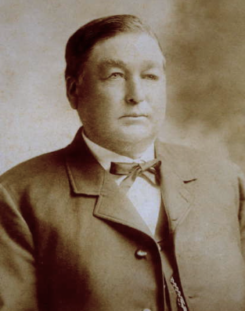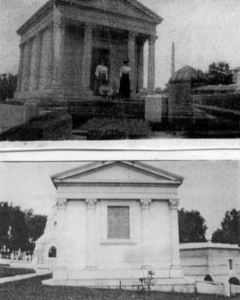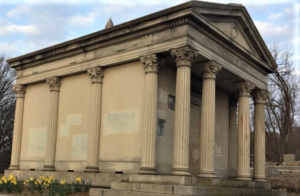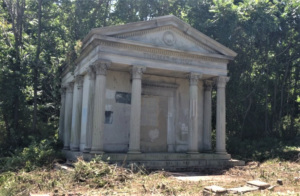Title: Liquor retailer, home builder
Birthdate: March 15, 1845
Death Date: March 26, 1906
Plot Location: Section 125, Lot A

In his Last Will and Testament, Thomas directed that $22,000 be used “for the purchase of a desirable burial lot at Mount Moriah Cemetery and for the erection of a suitable monument thereon.” That is the equivalent of nearly $750,000 in today’s dollars. To spend that amount of money, a large mausoleum, the largest in the cemetery, was the appropriate choice. That amount of money was probably more than enough, even with the many columns, the bronze doors, and the stained-glass window in the rear.
The story of how Thomas made that kind of money is not as clear as how he disposed of it. Information from some distant descendants has surfaced along with a few documented facts, both of which leave some unanswered questions. He was the youngest of either eight or nine children, born just as the great Irish famine began. The family lived in Antrim, Northern Ireland. Sources indicate that he and his sister Margaret were the only family members to emigrate.
He found his way to Maine where he married a woman whose name was either Jane McGeown or Jenny Gilmore. She was a dozen years older and probably had been married before. The next known fact is that he married Nancy Gilmore Johnson in Philadelphia on June 27, 1866. This was six months before he won a certificate of divorce by the state of Maine from his first wife in January of 1867.
Adding to that scenario, descendants have said that Nancy was Jane’s (or Jenny’s) aunt. According to the Will that Thomas left, Nancy had a daughter from a previous marriage. Eliza Jane Johnson was never on any census with Nancy, and the Hoys never had any children together. Two census reports say Nancy was eight years older than her husband, but other records confirm she was more than twice that.
Family issues aside, how did Thomas Hoy become so financially secure? The 1880 census lists his occupation as a hotel keeper, but there’s no documentation of that anywhere else. What has been confirmed by the city directories is that he was in the liquor trade from 1868 through 1895. Then, having invested his profits wisely, he bought some property and had homes built. There were at least two references to Thomas Hoy in the  newspaper real estate columns similar to the one shown here in 1890.
newspaper real estate columns similar to the one shown here in 1890.
He even paid tribute to this country’s system of free enterprise when he listed his occupation in the 1900 census as a “Capitalist.” Buying and selling in a free market economy and making wise financial decisions is what enabled the Hoys to live the rest of their lives off their investments. They also moved to the suburbs in 1898. His executors referred to where they lived as “the mansion.” It once looked out on Chester Pike in suburban Sharon Hill, about three miles southwest of Mount Moriah Cemetery.
Unfortunately, they only had a few years to enjoy their home there. Thomas died of chronic kidney disease in 1906 and Nancy died less than ten years later. Thomas allotted $64,000 in cash from the sale of stocks to be given to various relatives. Nancy willed that the remaining properties they owned were to be sold and the proceeds distributed in the same proportions to the same people.
proportions to the same people.
This early photograph shows how the front and back sides of the stately structure looked after Nancy’s death. The Greek temple she had built was large enough to house many more than just the two crypts that are there.
Years later, vandalism took its toll: During one break-in a skull was stolen in a plastic bucket. The thief was eventually caught and the skull was returned. 
As with most other mausoleums here, the window and doorway had to be blocked. An attempt to cover the graffiti on the walls left  visible scars. Sadly, there are no descendants who might want to restore the exterior finish. This color photo from 2012 shows the encroaching forest was about to swallow the entire hillside before it was cut back.
visible scars. Sadly, there are no descendants who might want to restore the exterior finish. This color photo from 2012 shows the encroaching forest was about to swallow the entire hillside before it was cut back.
It was an appalling chapter in the cemetery’s history. Meanwhile, the Hoy name inscribed above the front columns will be less remembered for the liquor he sold or the homes he built and more for the imposing edifice that was left behind.

Support the Friends of Mount Moriah
Help us in our mission to restore and maintain the beautiful Mount Moriah Cemetery by donating to our cause or volunteering at one of our clean-up events.

